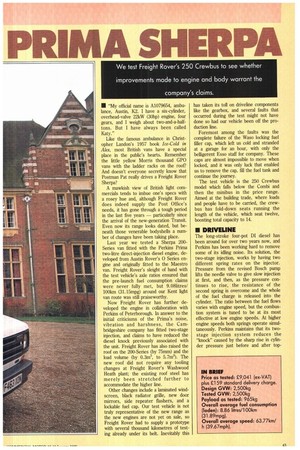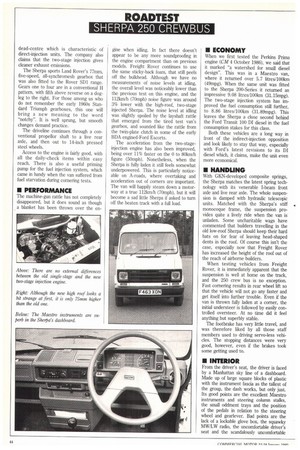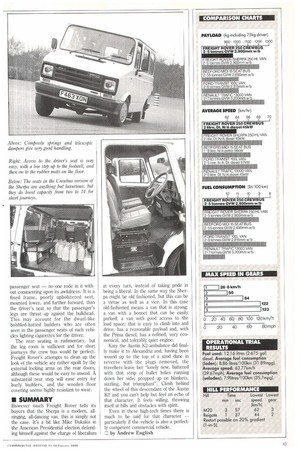SLOW SIPPING
Page 44

Page 45

Page 46

Page 47

If you've noticed an error in this article please click here to report it so we can fix it.
PRIMA SHERPA We test Freight Rover's 250 Crewbus to see whether improvements made to engine and body warrant the company's claims.
• "My official name is A1079654, ambulance, Austin, 1(2. I have a six-cylinder, overhead-valve 22kW (30hp) engine, four gears, and I weigh about two-and-a-halftons. But I have always been called Katy."
Like the famous ambulance in Christopher Landon's 1957 book Ice-Cold in Alex, most British vans have a special place in the public's hearts. Remember the little yellow Morris thousand GPO vans with the ladder racks on the roof? And doesn't everyone secretly know that Postman Pat really drives a Freight Rover Sherpa?
A mawkish view of British light commercials tends to imbue one's specs with a rosey hue and, although Freight Rover does indeed supply the Post Office's needs, it has gone through a tough period in the last five years — particularly since the arrival of the new-generation Transit. Even now its range looks dated, but beneath those venerable bodyshells a number of changes have been taking place.
Last year we tested a Sherpa 200Series van fitted with the Perkins Prima two-litre direct-injection diesel engine, developed from Austin Rover's 0 Series engine and originally fitted to the Maestro van. Freight Rover's sleight of hand with the test vehicle's axle ratios ensured that the pre-launch fuel consumption claims were never fully met, but 9.081itres/ 100Iun (31.15mpg) around our Kent light van route was still praiseworthy.
Now Freight Rover has further developed the engine in collaboration with Perkins of Peterborough. In answer to the initial criticisms of the Prima's noise, vibration and harshness, the Cambridgeshire company has fitted two-stage injection, and claims to have reduced the diesel knock previously associated with the unit. Freight Rover has also raised the roof on the 200-Series (by 75mtn) and the load volume (by 0.3m3, to 5.7m3). The new roof did not require any tooling changes at Freight Rover's Washwood Heath plant; the existing roof steel has merely been stretched further to accommodate the higher line.
Other changes include a laminated windscreen, black radiator grille, new door mirrors, side repeater flashers, and a lockable fuel cap. Our test vehicle is not truly representative of the new range as the new engines are not yet on sale, so Freight Rover had to supply a prototype with several thousand kilometres of testing already under its belt. Inevitably this has taken its toll on driveline components like the gearbox, and several faults that occurred during the test might not have done so had our vehicle been off the production line.
Foremost among the faults was the complete failure of the Waso locking fuel filler cap, which left us cold and stranded at a garage for an hour, with only the belligerent Esso staff for company. These caps are almost impossible to move when locked, and it was only luck that enabled us to remove the cap, fill the fuel tank and continue the journey.
The test vehicle is the 250 Crewbus model which falls below the Combi and then the minibus in the price range. Aimed at the building trade, where loads and people have to be carried, the crewbus has fold-down seats running the length of the vehicle, which seat twelve, boosting total capacity to 14.
• DRIVELINE The long-stroke four-pot DI diesel has been around for over two years now, and Perkins has been working hard to remove some of its idling noise. Its solution, the two-stage injection, works by having two different spring rates on the injector. Pressure from the revised Bosch pump lifts the needle valve to give slow injection at first, and then, as the pressure continues to rise, the resistance of the second spring is overcome and the whole of the fuel charge is released into the cylinder. The ratio between the fuel flows varies with engine speed, but the combustion system is tuned to be at its most effective at low engine speeds. At higher engine speeds both springs operate simultaneously. Perkins maintains that its twostage injection system reduces the "Imock" caused by the sharp rise in cylinder pressure just before and after top dead-centre which is characteristic of direct-injection units. The company also claims that the two-stage injection gives cleaner exhaust emissions.
The Sherpa sports Land Rover's 77mm, five-speed, all-synchromesh gearbox that was also fitted to the Rover Sill range. Gears one to four are in a conventional H pattern, with fifth above reverse on a dogleg to the right. For those among us who do not remember the early 1960s Standard Triumph gearboxes, this one will bring a new meaning to the word "notchy". It is well sprung, but smooth changes demand practice.
The driveline continues through a conventional propellor shaft to a live rear axle, and then out to 14-inch pressed steel wheels.
Access to the engine is fairly good, with all the daily-check items within easy reach. There is also a useful priming pump for the fuel injection system, which came in handy when the van suffered from fuel starvation during cornering tests.
• PERFORMANCE
The machine-gun rattle has not completely disappeared, but it does sound as though a blanket has been thrown over the en gine when idling. In fact there doesn't appear to be any more soundproofing in the engine compartment than on previous models. Freight Rover continues to use the same sticky-back foam, that still peels off the bulkhead. Although we have no measurements of noise levels at idling, the overall level was noticeably lower than the previous test on this engine, and the 112km/h (70mph) noise figure was around 3% lower with the high-roof, two-stage injected Sherpa. The noise level at idling was slightly spoiled by the layshaft rattle that emerged from the tired test van's gearbox, and sounded like the rattle from the twin-plate clutch in some of the early BDA engined-Ford Escorts.
The acceleration from the two-stageinjection engine has also been improved, being over 11% faster on the 0 to 801cm/h figure (50mph). Nonetheless, when the Sherpa is fully laden it still feels somewhat underpowered. This is particularly noticeable on A-roads, where overtaking and acceleration out of corners are important. The van will happily steam down a motorway at a true 112km/h (70mph), but it will become a sad little Sherpa if asked to turn off the beaten track with a full load.
• ECONOMY
When we first tested the Perkins Prima engine (CM 4 October 1986), we said that it marked "a watershed for small diesel design". This was in a Maestro van, where it returned over 5.7 litres/100Iun (49mpg). When the same unit was fitted to the Sherpa 200-Series it returned an impressive 9.08 litres/100Icm (31.15mpg). The two-stage injection system has improved the fuel consumption still further, to 8.86 litres/100bn (31.89mpg). This leaves the Sherpa a close second behind the Ford Transit 100 DI diesel in the fuel consumption stakes for this class.
Both these vehicles are a long way in front of the indirect-injection opposition and look likely to stay that way, especially with Ford's latest revisions to its DI diesel which, it claims, make the unit even more economical.
• IULNDLING
With GI{N-developed composite springs, the Sherpa matches the latest spring technology with its venerable I-beam front axle and live rear axle. The whole suspension is damped with hydraulic telescopic units. Matched with the Sherpa's stiff monocoque frame, the suspension provides quite a lively ride when the van is unladen. Some uncharitable wags have commented that builders travelling in the old low-roof Sherpa should keep their hard hats on for fear of leaving head-shaped dents in the roof. Of course this isn't the case, especially now that Freight Rover has increased the height of the roof out of the reach of airborne builders.
When testing vehicles from Freight Rover, it is immediately apparent that the suspension is well at home on the track, and the 250 crew bus is no exception. Fast cornering results in rear wheel lift so that the vehicle will not go any faster and get itself into further trouble. Even if the van is thrown fully laden at a corner, the initial understeer is followed by easily controlled oversteer. At no time did it feel anything but superbly stable.
The footbrake has very little travel, and was therefore liked by all those staff members used to driving servo-less vehicles. The stopping distances were very good, however, even if the brakes took some getting used to.
• INTERIOR
From the driver's seat, the driver is faced by a Manhattan sky line of a dashboard. Made up of large square blocks of plastic with the instrument fascia as the tallest of the group, the dash works, but only just. Its good points are the excellent Maestro instruments and steering column stalks, the small oddment trays and the position of the pedals in relation to the steering wheel and gearlever. Bad points are the lack of a lockable glove box, the squawky MW/LW radio, the uncomfortable driver's seat and the scandalously uncomfortable passenger seat — no one rode in it without commenting upon its awfulness. It is a fixed frame, poorly upholstered seat, mounted lower, and further forward, than the driver's seat so that the passenger's legs are thrust up against the bulkhead. This may account for the dwarf-like bobbled-hatted builders who are often seen in the passenger seats of such vehicles lighting cigarettes for the driver.
The rear seating is rudimentary, but the leg room is sufficient and for short journeys the crew bus would be perfect. Freight Rover's attempts to clean up the look of the vehicle are rather spoilt by the external locking arms on the rear doors, although these would be easy to amend. A substantial rear step will ease entry for burly builders, and the wooden floor covering seems highly resistant to wear.
II SUMMARY
however much Freight Rover tells its buyers that the Sherpa is a modern, allsinging, all-dancing van, this is simply not the case. It's a bit like Mike Dukakis in the American Presidential election defending himself against the charge of liberalism at every turn, instead of taking pride in being a liberal. In the same way the Sher pa might be old fashioned, but this can be a virtue as well as a vice. In this case old-fashioned means a van that is strong; a van with a bonnet that can be easily parked; a van with good access to the load space; that is easy to climb into and drive, has a reasonable payload and, with the Prima diesel, has a refined, very economical, and tolerably quiet engine.
Katy the Austin K2 ambulance did finally make it to Alexandria and, having been wound up to the top of a sand dune in reverse with the plugs removed, the travellers leave her "lonely now, battered with that strip of bullet holes running down her side, propped up on blankets, sizzling, but triumphant". Climb behind the wheel of this descendant of the Austin 1(2 and you can't help but feel an echo of that character. It feels willing, throwing itself at hills and obstacles with spirit.
Even in these high-tech times there is much to be said for that character — particularly if the vehicle is also a perfectly competent commercial vehicle.
by Andrew English
































































































